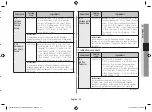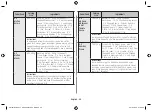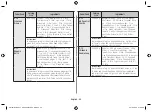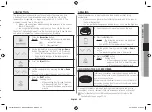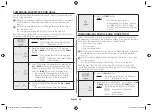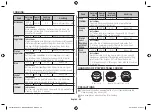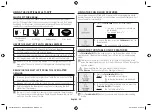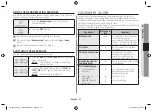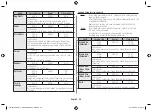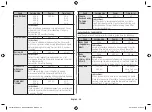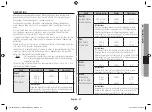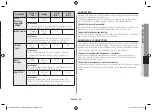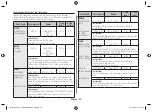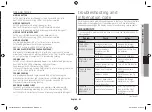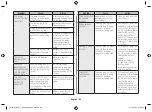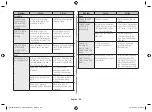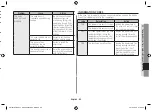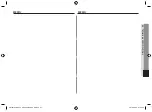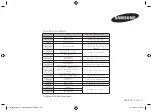
English - 53
English - 52
05
COOK
W
ARE
GUIDE
cooking guide
microWavEs
Microwave energy actually penetrates food, attracted and absorbed by its
water, fat and sugar content.
The microwaves cause the molecules in the food to move rapidly. The rapid
movement of these molecules creates friction and the resulting heat cooks
the food.
cooking
cookware for microwave cooking:
Cookware must allow microwave energy to pass through it for maximum
efficiency. Microwaves are reflected by metal, such as stainless steel,
aluminium and copper, but they can penetrate through ceramic, glass,
porcelain and plastic as well as paper and wood. So food must never be
cooked in metal containers.
food suitable for microwave cooking:
Many kinds of food are suitable for microwave cooking, including fresh or
frozen vegetables, fruit, pasta, rice, grains, beans, fish, and meat. Sauces,
custard, soups, steamed puddings, preserves, and chutneys can also be
cooked in a microwave oven. Generally speaking, microwave cooking is ideal
for any food that would normally be prepared on a hob. Melting butter or
chocolate, for example (see the chapter with tips, techniques and hints).
covering during cooking
To cover the food during cooking is very important, as the evaporated water
rises as steam and contributes to cooking process. Food can be covered in
different ways: e.g. with a ceramic plate, plastic cover or microwave suitable
cling film.
standing times
After cooking is over food the standing time is important to allow the
temperature to even out within the food.
cooking guide for frozen vegetables
Use a suitable glass pyrex bowl with lid. Cook covered for the minimum time
– see table. Continue cooking to get the result you prefer.
Stir twice during cooking and once after cooking. Add salt, herbs or butter
after cooking. Cover during standing time.
food
serving size
power
time (min.)
spinach
150 g
600 W
5-6
Instructions
Add 15 ml (1 tbsp.) cold water. Serve after 2-3 minutes
standing.
broccoli
300 g
600 W
8-9
Instructions
Add 30 ml (2 tbsp.) cold water. Serve after 2-3 minutes
standing.
peas
300 g
600 W
7-8
Instructions
Add 15 ml (1 tbsp.) cold water. Serve after 2-3 minutes
standing.
green beans
300 g
600 W
7½-8½
Instructions
Add 30 ml (2 tbsp.) cold water. Serve after 2-3 minutes
standing.
mixed
vegetables
(carrots/
peas/corn)
300 g
600 W
7-8
Instructions
Add 15 ml (1 tbsp.) cold water. Serve after 2-3 minutes
standing.
mixed
vegetables
(chinese
style)
300 g
600 W
7½-8½
Instructions
Add 15 ml (1 tbsp.) cold water. Serve after 2-3 minutes
standing.
cooking guide for fresh vegetables
Use a suitable glass bowl with lid. Add 30-45 ml cold water (2-3 tbsp.) for
every 250 g unless another water quantity is recommended – see table. Cook
covered for the minimum time – see table. Continue cooking to get the result
you prefer. Stir once during and once after cooking. Add salt, herbs or butter
after cooking. Cover during a standing time of 3 minutes.
hint:
Cut the fresh vegetables into even sized pieces. The smaller
they are cut, the quicker they will cook.
food
serving size
power
time (min.)
broccoli
250 g
500 g
900 W
4½-5
7-8
Instructions
Prepare even sized florets. Arrange the stems to the
centre. Serve after 3 minutes standing.
brussels
sprouts
250 g
900 W
6-6½
Instructions
Add 60-75 ml (5-6 tbsp.) water. Serve after 3 minutes
standing.
carrots
250 g
900 W
4½-5
Instructions
Cut carrots into even sized slices. Serve after 3 minutes
standing.
cauliflower
250 g
500 g
900 W
5-5½
7½-8½
Instructions
Prepare even sized florets. Cut big florets into halves.
Arrange stems to the centre. Serve after 3 minutes
standing.
courgettes
250 g
900 W
4-4½
Instructions
Cut courgettes into slices. Add 30 ml (2 tbsp.) water
or a knob of butter. Cook until just tender. Serve after
3 minutes standing.
CE1041DFB2_XTL_ DE68-04373A-00_EN.indd 53
2015-06-26 �� 1:26:13

